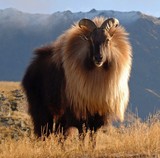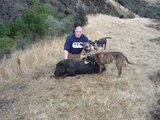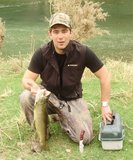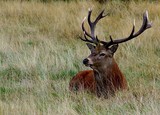Hunting Options
Deer, tahr and chamois hunting. Duck and pheasant shooting. Trout fishing. All on Cattle flat station, NZ.Fallow deer
 Fallow Deer
Bucks are 140-160 cm long and 90-100 cm shoulder height, and 60-85 kg in weight; does are 130-150 cm long and 75-85 cm shoulder height, and 30-50 kg in weight. Fawns are born in spring at about 30 cm and weigh around 4.5 kg. The life span is around 12-16 years. All of the Fallow deer have white spots on their backs, and black tips at the ends of their tails
Fallow Deer
Bucks are 140-160 cm long and 90-100 cm shoulder height, and 60-85 kg in weight; does are 130-150 cm long and 75-85 cm shoulder height, and 30-50 kg in weight. Fawns are born in spring at about 30 cm and weigh around 4.5 kg. The life span is around 12-16 years. All of the Fallow deer have white spots on their backs, and black tips at the ends of their tails
Himalayan Tahr
 The Himalayan Tahr is to the related to the wild goat. Its native habitat is in the rugged wooded hills and mountain slopes slopes of the Himalayas.
Their hooves have a flexible, rubbery core that allows them to grip smooth rocks, while a hard, sharp rim can lodge into small footholds.Males are larger and have different coloration and horn structure than the females. Adult Himalayan Tahrs range from 135 to 180 kg (300 to 400 lb) in weight, 120 to 170 cm in length, and 60 to 90 cm in height, with he males having having huge manes.
Himalayan Tahr are an introduced species in the South Island of New Zealand, with herds forming in the Southern Alps. In large numbers tahr are regarded as a pest because their browsing has an impact on native vegetation. Which makes them one of most sort after trophies in New Zealand.
The Himalayan Tahr is to the related to the wild goat. Its native habitat is in the rugged wooded hills and mountain slopes slopes of the Himalayas.
Their hooves have a flexible, rubbery core that allows them to grip smooth rocks, while a hard, sharp rim can lodge into small footholds.Males are larger and have different coloration and horn structure than the females. Adult Himalayan Tahrs range from 135 to 180 kg (300 to 400 lb) in weight, 120 to 170 cm in length, and 60 to 90 cm in height, with he males having having huge manes.
Himalayan Tahr are an introduced species in the South Island of New Zealand, with herds forming in the Southern Alps. In large numbers tahr are regarded as a pest because their browsing has an impact on native vegetation. Which makes them one of most sort after trophies in New Zealand.
Chamois
 Alpine chamois arrived in New Zealand in 1907 as a gift from the Austrian Emperor, Franz Joseph I. The first surviving releases were made in the Aoraki/Mount Cook region and these animals gradually spread over much of the South Island.
In New Zealand, hunting of chamois is unrestricted and even encouraged by the Department of Conservation to limit the animal's impact on New Zealand's native alpine flora.New Zealand chamois tend to weigh about 20% less than European individuals of the same age, suggesting that food supplies may be limited.As their meat is considered tasty, chamois are popular game animals. Chamois have two traits that are exploited by hunters. The first is that they are most active in the morning and evening when they feed. The second trait is that chamois tend to look for danger from below. This means that a hunter stalking chamois from above is less likely to be observed and more likely to be successful. In summer, the fur has a rich brown colour which turns to a light grey in winter. Distinct characteristics are a white face with pronounced black stripes below the eyes, a white rump and a black stripe along the back. Chamois can reach an age of 20 years.
Female chamois and their young live in herds; adult males tend to live solitarily for most of the year. During the rut which is May in New Zealand, males engage in fierce battles for the attention of unmated females. An impregnated female undergoes a gestation period of 20 weeks, after which a single kid is born. The kid is fully grown by three years of age
Alpine chamois arrived in New Zealand in 1907 as a gift from the Austrian Emperor, Franz Joseph I. The first surviving releases were made in the Aoraki/Mount Cook region and these animals gradually spread over much of the South Island.
In New Zealand, hunting of chamois is unrestricted and even encouraged by the Department of Conservation to limit the animal's impact on New Zealand's native alpine flora.New Zealand chamois tend to weigh about 20% less than European individuals of the same age, suggesting that food supplies may be limited.As their meat is considered tasty, chamois are popular game animals. Chamois have two traits that are exploited by hunters. The first is that they are most active in the morning and evening when they feed. The second trait is that chamois tend to look for danger from below. This means that a hunter stalking chamois from above is less likely to be observed and more likely to be successful. In summer, the fur has a rich brown colour which turns to a light grey in winter. Distinct characteristics are a white face with pronounced black stripes below the eyes, a white rump and a black stripe along the back. Chamois can reach an age of 20 years.
Female chamois and their young live in herds; adult males tend to live solitarily for most of the year. During the rut which is May in New Zealand, males engage in fierce battles for the attention of unmated females. An impregnated female undergoes a gestation period of 20 weeks, after which a single kid is born. The kid is fully grown by three years of age
Boar hunting
 Pig hunting in New Zealand had its origins when European sailors released pigs. Captain Cook’s liberations of pigs in the 1770s, while not the earliest, were probably the first successful releases. Wild black pigs, supposedly similar to the original type have become known as Captain Cookers. Today wild pigs come in a variety of colours as a result of interbreeding with domestic breeds over the last couple of hundred years.
Populations of wild pigs are found throughout much of New Zealand and local liberations by pig hunters are still taking place further increasing their range.In New Zealand we use to different styles of hunting and killing pigs. The first method of hunting pigs which is proffered is to use either, bailing dogs (which stand off and bark at the pig) then theres the holding dogs which bite onto the ears or legs of the pig so it cant get away until the hunter arrives. Ways in which we kill pigs is just to use a gun, or what we call sticking the pig which involves more danger, the technique in order to do this is to use a long knife and to thrust it into the heart of the animal.
Pig hunting in New Zealand had its origins when European sailors released pigs. Captain Cook’s liberations of pigs in the 1770s, while not the earliest, were probably the first successful releases. Wild black pigs, supposedly similar to the original type have become known as Captain Cookers. Today wild pigs come in a variety of colours as a result of interbreeding with domestic breeds over the last couple of hundred years.
Populations of wild pigs are found throughout much of New Zealand and local liberations by pig hunters are still taking place further increasing their range.In New Zealand we use to different styles of hunting and killing pigs. The first method of hunting pigs which is proffered is to use either, bailing dogs (which stand off and bark at the pig) then theres the holding dogs which bite onto the ears or legs of the pig so it cant get away until the hunter arrives. Ways in which we kill pigs is just to use a gun, or what we call sticking the pig which involves more danger, the technique in order to do this is to use a long knife and to thrust it into the heart of the animal.
Fishing
 Cattle Flat station is situated along 16 miles of the world famous mataura river.
Cattle Flat station is situated along 16 miles of the world famous mataura river.The mataura river gets its fame from the massive mayfly hatches the occur on it.
Because of the hatches of the mayfly the brown trout of the river rise up to take the fly which makes fly fishing an exciting activity to do well staying at cattle flat.
Red stag
 The Red Deer (Cervus elaphus) is one of the largest deer species. The Red Deer inhabits most of Europe, the Caucasus Mountains region, Asia Minor and parts of western and central Asia. It also inhabits the Atlas Mountains region between Morocco and Tunisia in northwestern Africa, being the only species of deer to inhabit Africa. Red Deer have been introduced to other areas including Australia, New Zealand and Argentina. In many parts of the world the meat (venison) from Red Deer is used as a food source. (wikipedia)
The Red Deer (Cervus elaphus) is one of the largest deer species. The Red Deer inhabits most of Europe, the Caucasus Mountains region, Asia Minor and parts of western and central Asia. It also inhabits the Atlas Mountains region between Morocco and Tunisia in northwestern Africa, being the only species of deer to inhabit Africa. Red Deer have been introduced to other areas including Australia, New Zealand and Argentina. In many parts of the world the meat (venison) from Red Deer is used as a food source. (wikipedia)